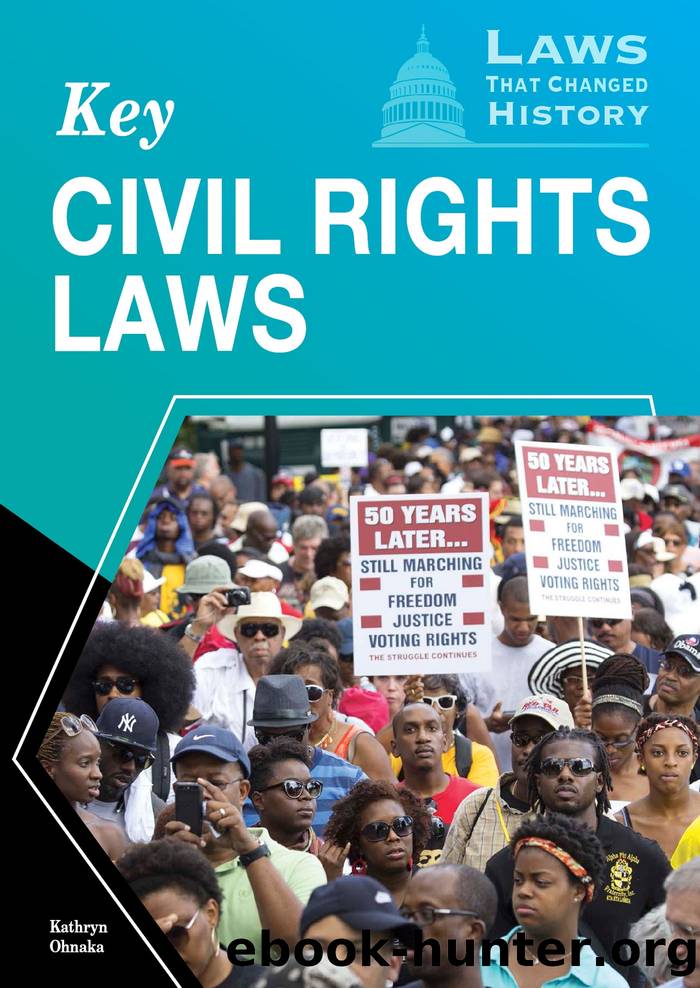Key Civil Rights Laws by Kathryn Ohnaka

Author:Kathryn Ohnaka
Language: eng
Format: epub
Publisher: Cavendish Square Publishing, LLC
Published: 2019-11-06T00:00:00+00:00
Margaret Sanger opened the first US birth control clinic for women in 1916. She believed women should have a right to choose if and when to have children.
Womenâs Family and Heath Rights
For most of Americaâs history, womenâs health was largely overlooked, and women were left to their own devices for menstrual and birth care as well as overall health. Birth control was illegal until 1965 for married women and until 1972 for single women, but women often used dangerous or illegal methods before then.8
The first American birth control clinic was opened in 1916 by Margaret Sanger. She argued that poverty and high birth rates risked womenâs lives, and they should be able to choose when to have children or even whether they wanted to have them at all. She also founded the American Birth Control League in 1921, which would later become Planned Parenthood. Birth control pills were invented in 1960, giving women much greater control over their own reproductive choices. In 1973, Roe v. Wade was decided, allowing women access to legal abortion. In 2010, the Affordable Care Act mandated that health insurance provide free birth control. The ability to use safe birth control allowed women to have safer pregnancies and childbirth and work as they chose.9
Women are still often subjected to violence, either in domestic situations or as gender-related hate crimes. In 1994, the Violence Against Women Act was passed, which set aside funding for womenâs shelters, rape prevention programs, and programs to educate people about domestic violence. It was renewed and expanded in 2013 to cover Native Americans, same-sex couples, and victims of human trafficking. However, it lapsed in 2018 under the Trump administration.
Womenâs Education
Schools today are open to women and men taking any classes that please them, but it wasnât always so. Starting in the 1800s, women could attend school through college, but in practice, many schools found ways to exclude women. High schools often segregated students into âgender-appropriate classes,â such as home economics for girls and industrial arts for boys, and womenâs career choices after school were limited.
As the civil rights movement pushed for more rights for women, girls began to insist on having equal access to classes. In 1972, the government enacted Title IX of the Federal Education Amendments. Title IX protects people from discrimination based on sex in education programs or activities that receive federal financial assistance. This means that any school that takes government money must grant equal opportunities to men and women. Title IX helped open many new career fields to women.
Download
This site does not store any files on its server. We only index and link to content provided by other sites. Please contact the content providers to delete copyright contents if any and email us, we'll remove relevant links or contents immediately.
Pale Blue Dot by Carl Sagan(4867)
Cracking the GRE Premium Edition with 6 Practice Tests, 2015 (Graduate School Test Preparation) by Princeton Review(4186)
Pocahontas by Joseph Bruchac(4100)
Unfiltered by Lily Collins(3932)
The Emotionary: A Dictionary of Words That Don't Exist for Feelings That Do by Eden Sher(3287)
The Daily Stoic by Holiday Ryan & Hanselman Stephen(3201)
Factfulness_Ten Reasons We're Wrong About the World_and Why Things Are Better Than You Think by Hans Rosling(3169)
The President Has Been Shot!": The Assassination of John F. Kennedy by Swanson James L(3025)
Sapiens and Homo Deus by Yuval Noah Harari(2951)
Rogue Trader by Leeson Nick(2950)
The 48 laws of power by Robert Greene & Joost Elffers(2899)
The Innovators: How a Group of Hackers, Geniuses, and Geeks Created the Digital Revolution by Walter Isaacson(2713)
The Rape Of Nanking by Iris Chang(2709)
Gettysburg by Iain C. Martin(2630)
Almost Adulting by Arden Rose(2630)
The Plant Paradox by Dr. Steven R. Gundry M.D(2518)
500 Must-Know AP Microeconomics/Macroeconomics Questions(2510)
In the Woods by Tana French(2502)
Make by Mike Westerfield(2261)
